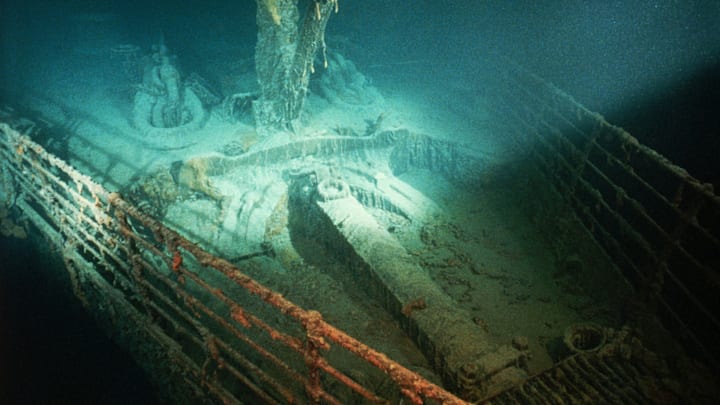On April 14, 1912, the RMS Titanic collided with an iceberg, kicking off one of the 20th century’s most devastating civilian catastrophes. But the date typically cited for the ship’s sinking is April 15. And that’s because, as anyone who’s seen James Cameron’s Titanic (1997) already knows, the vessel didn’t plunge immediately to its icy doom—the whole process took a good two hours and change.
Ship Meets Iceberg

The starboard side of the Titanic brushed up against the iceberg at 11:40 p.m. the night of April 14, causing enough damage that at least five watertight compartments in the hull began to fill with water. After a brief investigation, the ship’s chief designer Thomas Andrews determined that they wouldn’t be able to stay afloat, and by midnight, the crew had started preparing the lifeboats.
The scene over the next two hours gradually escalated into pandemonium as passengers were roused from their berths and loaded—women and children first—into a fleet of lifeboats that clearly couldn’t accommodate everyone. At about 2 a.m., the ship’s bow had tipped so far beneath the surface that its stern was partially above the water, and at 2:17 a.m., wireless operator Jack Phillips transmitted one last distress call.
You May Also Like:
- Mental Floss Presents: The Titanic Timeline
- 70 Huge Facts About the Titanic
- 10 Wild Conspiracy Theories About the Sinking of the ‘Titanic’
Add Mental Floss as a preferred news source!
Beneath the Surface
Over the next three or so minutes, the lights would shut off, and the bow’s downward trajectory would force the stern to break from the ship. It’s generally believed that the bow started to sink, and the stern moved into a vertical position before sinking, too.
By 2:20 a.m., the Titanic had vanished. As for how long it took for the ship to actually hit the ocean floor, it depends on whom you ask. In his book The Discovery of the Titanic, Robert Ballard—the oceanographer who discovered the wreck—estimated that the descent may have lasted just six minutes, though he made it clear that “there are simply too many variables involved” to be sure.
Where Did the Titanic Sink?
The Titanic sank in the North Atlantic Ocean about 370 miles southeast of Newfoundland. Its rough position wasn’t a mystery—after all, ships showed up to rescue survivors in the area. But technology to locate lost shipwrecks wasn’t very advanced in 1912, and it would be another 73 years before Ballard and his team found the vessel some 13,000 feet under the surface.
A version of this story ran in 2022; it has been updated for 2025.
